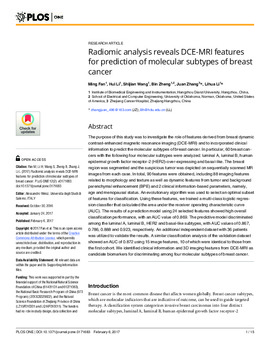| dc.contributor.author | Ming Fan | |
| dc.contributor.author | Hui Li | |
| dc.contributor.author | Shijian Wang | |
| dc.contributor.author | Bin Zheng | |
| dc.contributor.author | Juan Zhang | |
| dc.contributor.author | Lihua Li | |
| dc.date.accessioned | 2017-04-10T23:19:04Z | |
| dc.date.available | 2017-04-10T23:19:04Z | |
| dc.date.issued | 2017-02-06 | |
| dc.identifier.citation | Fan M, Li H, Wang S, Zheng B, Zhang J, Li L (2017) Radiomic analysis reveals DCE-MRI features for prediction of molecular subtypes of breast cancer. PLoS ONE 12(2): e0171683. doi:10.1371/journal.pone.0171683 | en_US |
| dc.identifier.uri | https://hdl.handle.net/11244/50426 | |
| dc.description | This work was supported in part by financial support from the National Natural Science Foundation of China (61271063 and 61401131), the National Basic Research Program of China (973 Program) (2013CB329502), and the Natural Science Foundation of Zhejiang Province of China (LZ15F010001 and LQ14F010011). | en_US |
| dc.description | | en_US |
| dc.description.abstract | The purpose of this study was to investigate the role of features derived from breast dynamic contrast-enhanced magnetic resonance imaging (DCE-MRI) and to incorporated clinical information to predict the molecular subtypes of breast cancer. In particular, 60 breast cancers with the following four molecular subtypes were analyzed: luminal A, luminal B, human epidermal growth factor receptor-2 (HER2)-over-expressing and basal-like. The breast region was segmented and the suspicious tumor was depicted on sequentially scanned MR images from each case. In total, 90 features were obtained, including 88 imaging features related to morphology and texture as well as dynamic features from tumor and background parenchymal enhancement (BPE) and 2 clinical information-based parameters, namely, age and menopausal status. An evolutionary algorithm was used to select an optimal subset of features for classification. Using these features, we trained a multi-class logistic regression classifier that calculated the area under the receiver operating characteristic curve (AUC). The results of a prediction model using 24 selected features showed high overall classification performance, with an AUC value of 0.869. The predictive model discriminated among the luminal A, luminal B, HER2 and basal-like subtypes, with AUC values of 0.867, 0.786, 0.888 and 0.923, respectively. An additional independent dataset with 36 patients was utilized to validate the results. A similar classification analysis of the validation dataset showed an AUC of 0.872 using 15 image features, 10 of which were identical to those from the first cohort. We identified clinical information and 3D imaging features from DCE-MRI as candidate biomarkers for discriminating among four molecular subtypes of breast cancer. | en_US |
| dc.language.iso | en_US | en_US |
| dc.publisher | PLos One | |
| dc.relation.ispartofseries | PLoS ONE 12(2): e0171683 | |
| dc.relation.uri | http://www.plosone.org/article/info%3Adoi%2F10.1371%2Fjournal.pone.0171683 | |
| dc.rights | Attribution 3.0 United States | |
| dc.rights.uri | https://creativecommons.org/licenses/by/3.0/us/ | |
| dc.subject | Breast cancer,Magnetic resonance imaging,Breast tumors,Forecasting,Invasive ductal carcinoma,Skewness,Differentiated tumors,Cancer treatment | en_US |
| dc.title | Radiomic analysis reveals DCE-MRI features for prediction of molecular subtypes of breast cancer | en_US |
| dc.type | Research Article | en_US |
| dc.description.peerreview | Yes | en_US |
| dc.description.peerreviewnotes | http://www.plosone.org/static/editorial#peer | en_US |
| dc.identifier.doi | 10.1371/journal.pone.0171683 | en_US |
| dc.rights.requestable | false | en_US |

